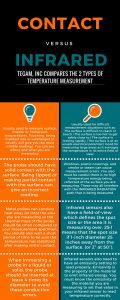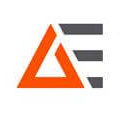CONTACT or INFRARED Temperature Measurement?
投稿 3月 06, 2018 によって Advanced Energy Editor
What is Best for Your Application?
CONTACT or INFRARED?
.jpg) |
| Contact vs. Non-Contact Thermometers Infographic |
Each method has its own set strengths and weaknesses.
Contact Measurement is usually used to measure surface, interior or immersion temperatures. Touching, being inserted into or submerged in usually will give you the most reliable readings. You can see where and what you are measuring.
What to look out for:
- The probe should have solid contact with the surface. Being tipped or making partial contact with the surface can give an incorrect reading.
- Metal probes can conduct heat away (or into) the area you are measuring so the thermal mass of the probe should be small compared to your measurement specimen. You should also wait a short period of time to be sure the temperature has stabilized after making initial contact.
- When immersing a probe in a liquid or solid, the probe should be inserted at lease 4 times its diameter to avoid these conduction errors.
- When working with food products, the probes will need to meet food handling requirements such as stainless steel, no seams or crevices where food can be trapped. The probe should also be easily cleaned or washed.
Infrared Measurement can solve some difficult measurement situations such as:
- The surface is difficult to reach or touch
- The surface is too hot to get safely close to
- The surface is moving rapidly
- The surface is at an unsafe electrical potential
Infrared is also good for measuring large areas as it averages the temperature in its entire field of view.
- When making an infrared temperature measurement you must consider the nature if infrared measurement. Infrared measures the infrared radiation coming off a surface, so you must be aware of anything that can interfere with the path. Items such as windows, plastic coverings, and smoke or steam can cause measurement errors. You also must be careful there is no high temperature energy being reflected of the surface you are measuring.
- Infrared sensors also have a field-of-view which defines the spot size or the area it is measuring over. 25:1 means that the spot size if 1-inch diameter 25 inches away from the surface. (or 2” at 50”).
- Infrared sensors also need to have an emissivity setting to read properly. Emissivity is the property of the material to emit infrared energy. You must know the emissivity of the material you are measuring to set that value in your infrared sensor to read temperature correctly.
- You can look up the emissivity for most common material in a table or make a contact measurement and adjust the emissivity of your infrared system so that its reading agrees with the contact measurement.
You can visit the line of TEGAM Digital Thermometry products here. Learn more about the advantages of contact versus non-contact/infrared thermometers here.
